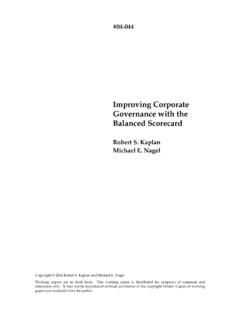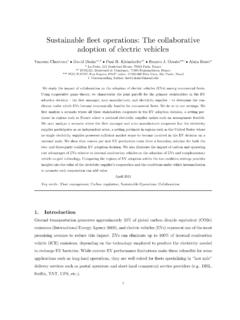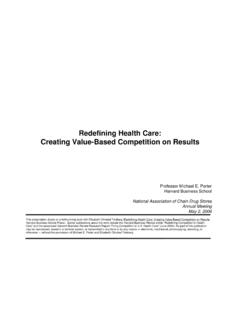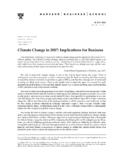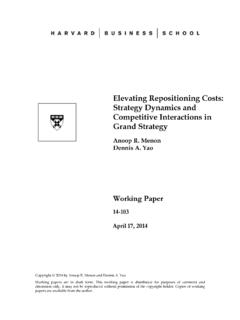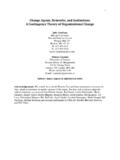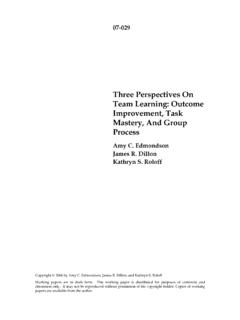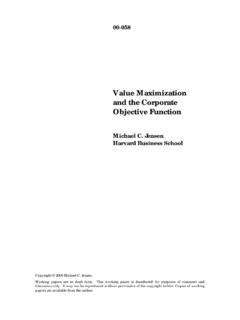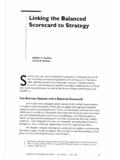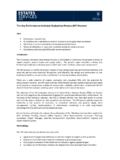Transcription of The Demise of Cost and Profit Centers Final12 8 2006
1 07-030 Copyright 2006 by Robert S. Kaplan Working papers are in draft form. This working paper is distributed for purposes of comment and discussion only. It may not be reproduced without permission of the copyright holder. Copies of working papers are available from the author. The Demise of cost and Profit Centers Robert S. Kaplan 1 The Demise of cost and Profit Centers By Robert S. Kaplan Abstract The balanced scorecard offers a previously unrecognized benefit: a new way of looking at the traditional organizational structure of cost and Profit Centers . Every unit, by contributing to effective strategy execution, has the opportunity to support and create Profit .
2 This capability has important implications for specifying objectives and evaluating the performance of all organizational units. In the mid-1960s, three Harvard Business School faculty members, Robert Anthony, John Dearden, and Richard Vancil, authored a classic contribution to management control, Management Control Systems (MCS).1 The MCS book, among many insights, contained an important taxonomy to describe the structure and systems used by different decentralized organization units. The taxonomy explored the relationship between the design of decentralized organizations and the motivations of and incentives for those who manage them. MCS identified five different types of decentralized organizational units.
3 1. The Profit center . Many operating unit managers have responsibility and authority for both production and sales. They make decisions about what products and services to produce, how to produce them, their quality level, price, sales and distribution systems. But these managers may not have the authority to determine the level of capital investment in their facilities. In these cases, operating Profit may be the single best (short-term) performance measure for how well the managers are creating value from the resources the company has put at their disposal. Such a unit, in which the manager has almost complete operational decision-making responsibility and is evaluated by a straightforward Profit measure, is called a Profit center .
4 2. The Investment center . When a local manager has all the responsibilities described above as well as the responsibility and authority for his or her center s working capital and physical assets, the manager is running an investment center . The performance of such a unit is best measured with a metric that relates profits earned to the level of physical and financial assets employed in the center . Investment center managers are evaluated with metrics as return on investment (ROI) and economic value-added. 3. The Standard cost center . A standard cost center is a production or operating unit in which someone other than the local manager determines the outputs that will be produced as well as the expected inputs required to produce each unit of output.
5 Industrial engineers and cost accountants specify the quantity and price standards for the materials, labor, energy, and machine time required to produce each widget, the generic term for a manufactured good, . The cost center manager s job is to produce the 1 Authors, Management Control Systems, Richard D. Irwin publishing, 1965. The book, with new authors, is now in its 12th edition. 2demanded quantity and mix of widgets in an efficient manner, as determined by the standard cost system. Standard cost Centers are also found in service industries, such as the fast-food business, banking, and health care, where cost accountants establish standard costs for producing hamburgers and milk shakes, processing checks and deposits, or performing laboratory and radiological tests.
6 The performance of a cost center manager is evaluated by a complex system of cost variances that compare actual to budgeted cost performance. 4. The Revenue center . A revenue center , typically a market or sales unit, has responsibility for selling the finished goods produced by a manufacturing division (a cost center ) or the products offered by a service organization. Because a revenue center typically has discretion in setting the selling price (or in negotiating discounts off the list price), it is held accountable for generating targeted levels of gross revenues. It often compensates its sales force with commissions based on the gross revenues they generate. 5. The Discretionary Expense center .
7 Staff units, including general and administrative (G&A) departments, such as finance, human resources, and legal; research and development (R&D) departments; and marketing units such as those performing advertising and promotion, are usually treated as discretionary expense Centers . The output from these units is not easily measured in financial terms, and the relationship between the resources they expend (inputs) and the outcomes they produce is weak. Companies control these discretionary expense Centers by negotiating and eventually authorizing an annual budget and then monitoring whether their actual spending remains within the budgeted amounts. The MCS taxonomy reveals that decentralization can take many forms.
8 Repetitive processes producing well-specified and easily measured outputs can be managed as standard cost Centers , where the managers must meet externally generated demands for products according to a cost -minimizing, efficient standard. Marketing departments can be organized as revenue Centers , with the objective of meeting targeted goals in sales revenue, market share, or contribution margin. Some functions for which the output is not easily measurable or where the outputs are not causally and deterministically related to the inputs expended cannot be controlled by the use of traditional techniques such as standard costs or budgets. These functions are usually organized as discretionary expense Centers in which the level of expenditure and the number of personnel are determined by negotiation with central management to determine appropriate levels of quality and service.
9 Much greater decentralization can occur when an operating unit is given responsibility both for acquiring inputs and selling or distributing its outputs. Such units can be organized as Profit or investment Centers . For all five types of organizational units, however, only financial metrics cost , revenue, gross margin, profits , or ROI were used for motivation, alignment, and rewards. The balanced scorecard Revolution When Dave Norton and I introduced the balanced scorecard in the 1990s, we described the limitations of financial metrics, such as profits and ROI, for motivating and 3evaluating the performance of Profit and investment Centers . We claimed that financial metrics were no longer sufficient for measuring the annual performance of the managers of these units in creating long-term value.
10 We advocated that the performance of such managers must include a variety of nonfinancial metrics designed to capture how well the unit s intangible assets built and expanded relationships with targeted customers; improved the quality and responsiveness of operating processes; created and introduced new products and services; enhanced the motivation and capabilities of employees; leveraged investments in data bases and information technology; and aligned the culture and climate linked to the unit s vision, mission, and strategy. The BSC soon proved to be a more general and powerful performance management framework for units previously treated as Profit and investment Centers . Less well appreciated, however, is how the BSC has actually eliminated the need to treat the remaining decentralized units as standard cost Centers , revenue Centers , or discretionary expense Centers .
